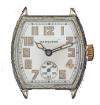About the time Hamilton purchased Illinois Watch Company, the Lancaster PA railroad watch manufacturer put eight traditional wrist watches on the market. Previously, they seemed to have walked on eggshells. For example, from 1917-1925, they only offered a Cushion. In 1927, they opened up. Shown below are five of their offerings. Not pictured are the Tonneau Plain, Cushion Plain and the Square Plain.
Tonneau Engraved
Barrel Plain
Barrel Engraved
Cushion Plain
Square Cut Corner Plain
|
|
|
|
|
||||||||||
How do you account for the Company taking its time to get into the wristwatch business?
Hamilton was a railroad watch company. They dominated the industry. They sold more railroad watches than any other company. 50% of their watch production went to the railroads.
While pocket watches accounted for an average of 33,000 units a year (and that doesn’t include sales of Illinois watches), initial wristwatch sales accounted for about 1500 units a year. Where would you put your resources if you were Hamilton’s management?
People often cite Elgin’s surge in wristwatches. In 1919, they manufactured 9,000 Cushions with 7 Jewel movements. Elgin was a mass producer of watches. Their volume in wristwatches was six times more than Hamilton. Maybe that seems like a lot to you. In comparison to Elgin’s total volume, it’s small. Elgin’s watch also sold for a fraction of the Hamilton in 1919.
It took a few years for Hamilton to become a powerhouse in wristwatches. The acquisition of an existing and successful wristwatch manufacturer and a Hamilton vice-president (Robert E. Miller) who took over operations, put Hamilton in the game. Hamilton’s purchase of Illinois Watch Company in 1928 for $5 million allowed the Company to take command of the business – just as they had in railroad watches and later, consumer watches.
Hamilton was created by a series of events that some might call a perfect storm. After a number of attempts to start a watch company in Lancaster, Pennsylvania (Adams & Perry; Lancaster Watch Company and Keystone), Hamilton emerged with enough financial resources to continue operating as a viable company. Henry Cain of Keystone, reorganized the Company and designed the first Hamilton watch and made it specifically for the railroad industry.
Cain recognized a niche opportunity and carried through.
On April 19, 1891, a devastating train wreck occurred in Kipton, Ohio (known as the Great Kipton Train wreck). Investigators blamed the wreck on the failure of an engineer’s watch. In 1893 and as a result of the Kipton investigation, the industry established standards that railroad watches needed meet. On December 14, 1892, Hamilton occupied the old facilities of Keystone and began operations.
Cain saw the writing on the wall and designed watches to meet the standards before anyone else. Thus, Hamilton became a manufacturer of railroad watches. Hundreds of the finest watchmakers in the world converged in Lancaster to build timepieces to meet the demand of railroad standard time.
The busy Hamilton Watch Company just didn’t see the economics of making wristwatches since they didn’t meet railroad certification standards. In 1928, the opportunity emerged and Hamilton executives didn’t need to get their hands dirty in a part of the industry they didn’t know or understand.
Thank you Illinois Watch Company.
Railroad Time Standards:
1. Only American-made watches may be used (depending on availability of spare parts)
2. Only open-faced dials, with the stem at 12 o’clock
3. Minimum of 17 functional jewels in the movement
4. 16 or 18-size only
5. Maximum variation of 30 seconds (approximately 4 seconds daily) per weekly check
6. Watch adjusted to at least five positions: Face up and face down (the positions a watch might commonly take when laid on a flat surface); then crown up, crown pointing left, and crown pointing right (the positions a watch might commonly take in a pocket). Occasionally a sixth position, crown pointing down, would be included.
7. Adjusted for severe temperature variance and isochronism (variance in spring tension)
8. Indication of time with bold legible Arabic numerals, outer minute division, second dial, heavy hands,
lever used to set the time (no risk of having the stem left out, thus inadvertently setting the watch to an erroneous time)
9. Breguet balance spring
10. Micrometer adjustment regulator
11. Double roller
12. Steel escape wheel
13. Anti-magnetic protection (after the advent of diesel locomotives)
As you can see from the above requirements, wristwatches did not meet the standards of the railroad.
Copyright 2006-2017 | All Rights Reserved





